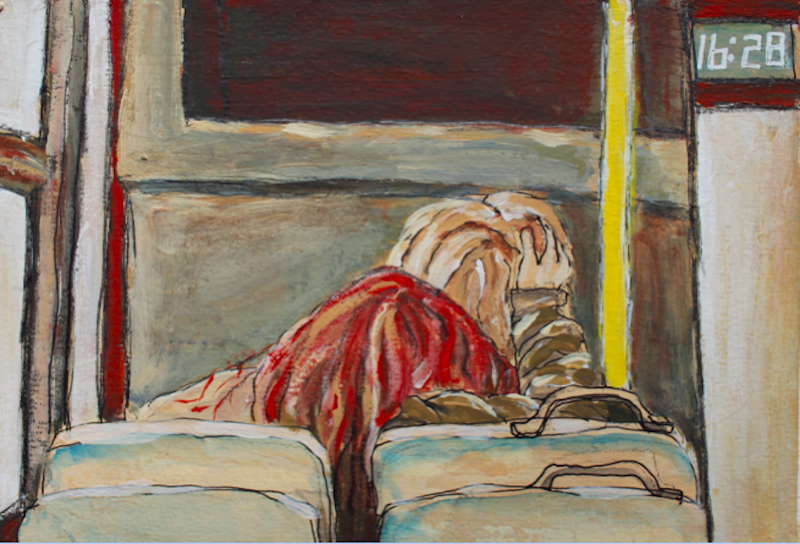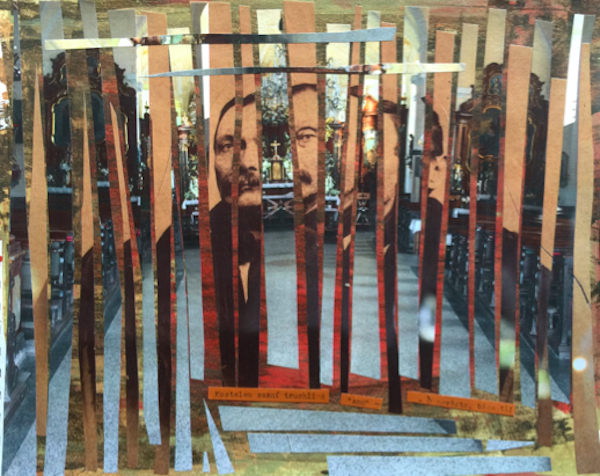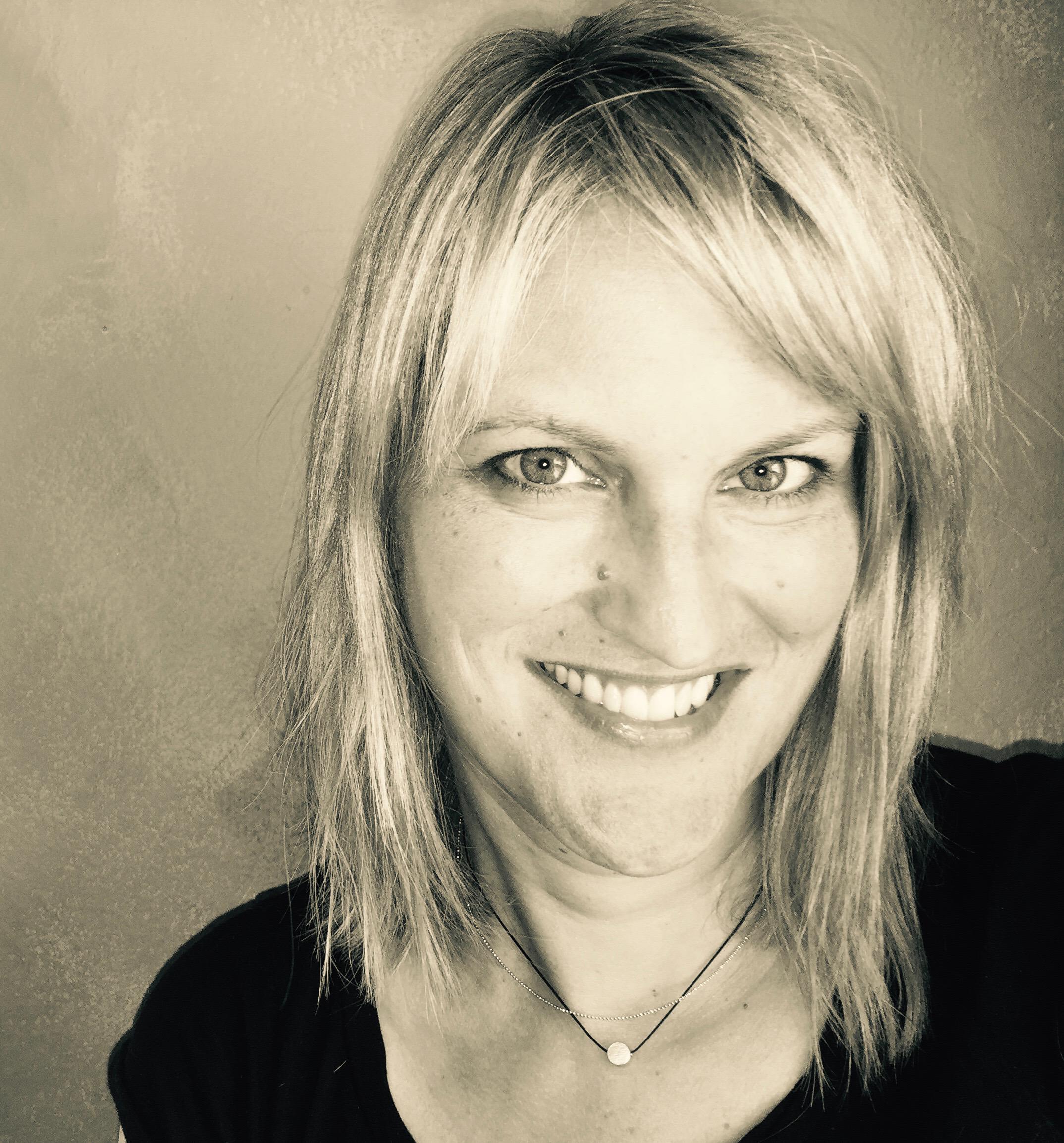Essay by Kelcey Parker Ervick
Collaging a Woman’s Life: Božena Němcová (1820–1862)

Dear B.,
After class on Wednesday (streda, the middle day), I took a train with classmates to the Sedlec Ossuary, the Bone Church. We arrived at the Kutná Hora station, about an hour from Prague, and rode in a bus through a panelak complex of Soviet-era apartments. A teenaged couple boarded the bus and sat in front of me. Her head resting on his shoulder, her magenta hair cascading over her jacket, her fingers clutching his thick blond hair.
I thought of the young love of Kristla and Míla. Of Bára and the huntsman. Of Viktorka and the soldier. Of me and my husband: we were young lovers once. Maybe the couple on the bus would have a happy ending, or maybe they were already doomed.
k.
I wrote this postcard to Božena Němcová in 2012, when I was in Prague to take a Czech language class. Years earlier on a previous trip, I’d first come across her work when I bought a book of Němcová's fairy tales for my daughter. By the time I started writing postcards to her, this woman, who’d been dead for 150 years and was largely unknown outside the Czech Republic, had become the subject of my own book.
That book is The Bitter Life of Božena Němcová: A Biographical Collage, published this fall by Rose Metal Press. But four years ago, I found myself deeply immersed in sifting through whatever fragments about Němcová I could find, trying (impossibly, as it turned out) to learn enough Czech to translate her letters. I wanted to better understand her, to figure out why so many biographical summaries described her marriage as unhappy, her life as “bitter.” And I wanted to figure out what to do about my own unhappy marriage, then in its seventeenth year.
In other words: I couldn’t separate the facts I was learning about Božena Němcová’s life from my own life or my research experience. Nor did I want to.
Watching those young lovers on the bus, I was overcome with emotion. Not only was I thinking of my own marriage (we had met as teenagers), I was thinking about Němcová’s marriage, which was likely arranged for her as a teenager and unhappy from the start. It’s no wonder her stories often featured young lovers who fight social customs to be together. In her seminal 1854 book Babička (The Grandmother), the title character intervenes for Kristla, who wants to marry Jacob Míla and not the man she’s engaged to. The Grandmother also intervenes for the Princess, who wants to marry her art teacher instead of a prince.
But not all of Němcová’s stories of young love end happily. The beautiful Viktorka runs off with a foreign soldier and returns to her village a year later, alone and pregnant. She drowns her baby and spends the rest of her years roaming the woods and singing lullabies at the water’s edge. Although most of her heroines end up happily married, Němcová was constantly writing against the all-too-common story in which women marry unsuitable men. (In one unpublished story, she wrote of marriage as blood sacrifice and bondage.)
In her 1988 book Writing a Woman’s Life, Carolyn Heilbrun argued that biographers need to move beyond the marriage plot when writing about women. Instead, she pointed out, we should reframe women’s lives in terms of the quest plot so often found in narratives about men, one based on ambition rather than on marriage and family. Heilbrun identified four common approaches to writing a woman’s life: a biographer writes it (first approach) or the woman writes it herself—as memoir (second approach), as fiction (third approach), or even as a sort of conjuring. With that fourth approach, the woman brings events into being through the act of writing.
In my book, I was the biographer of one woman, Božena Němcová, but I was also writing my own life, and, in the process, I began to uncover a new plot for myself.
As I worked on Němcová’s biography, I was interested in revealing something much bigger than one woman’s life story: I wanted to explore what happens when the different voices that attempt to tell a life are juxtaposed with one another—how the words of a scholar, a biographer, a friend, a lover, and even the subject herself (in letters and stories) speak to and against one another. For me, that 150-year-long conversation—full of textual contradictions, scholarly quarrels, and gaps—was the story I wanted to tell, and it led me to my collage-based form.
For example, regarding her husband, in The Bitter Life of Božena Němcová I quote a friend of the couple as saying: “He was very proud of his wife and enjoyed her literary work.” On the next page, I quote a contemporary scholar, who says: “He did not wish his wife to be a writer—wanting her to be a devoted and practical housewife.”
Counterbalancing all this is Němcová’s own voice, which grounds readers in her lived reality. In a letter to her son, she said of her husband: “I would not have stayed with him one year if it had not been for you. In order not to be dependent on [him] for everything, I became a writer.”
I was captivated by this voice of hers. In the following letter to her husband, she is direct, assured, and disillusioned with men:
I had more than one admirer—one had a mind, the other a body, that one a heart, another intelligence, but in the end I never found what I longed for: a man to whom I would gladly subject myself. [sic] —All had their weaknesses. I would choose none of them for a husband.
Němcová’s words resonated with my own desires for happiness, freedom, and writing outside of the marriage plot. This piece added a new dimension to the project: What happens in the biographer’s life through the process of writing a subject’s life? Biographers often feel drawn toward their subjects for personal reasons. I was drawn to Božena Němcová—an almost mythic literary figure in a city I loved—as a fellow writer, mother, and unhappily married wife.
In the postcards I began writing to her in 2012, I alluded to books of letters by other Prague-based writers who are important to me: Rainer Maria Rilke’s Letters to a Young Poet, Franz Kafka’s Letters to Milena, Bohumil Hrabal’s Total Fears: Letters to Dubenka, and Vaclav Havel’s Letters to Olga. These quotes helped me develop themes of youthful mistakes, literary ambition, and, of course, the power of letter writing. I chose this 1922 quote by Kafka as the epigraph to my “Postcards to Božena”:
Writing letters is actually an intercourse with ghosts, and by no means just the ghost of the addressee but also with one’s own ghost, which secretly evolves in the letter one is writing.
Rilke’s words to the young poet also became a refrain as I headed toward a divorce from my high school sweetheart:
Young people often err since it is in their nature to be impatient. But what is to follow? What should fate do if this takes root, this heap of half-broken things that they call togetherness and that they would like to call their happiness?
Němcová was on the cusp of divorce with her husband when she died at age 42. In 2012, I was 41, and it was time to confront my own “heap of half-broken things.” Like most women, I’d been living the marriage plot. But early on in the postcards, I reframed my narrative as a quest plot: learn about Němcová, write the book, conjure a happy ending to my unhappy marriage—and find a Czech typewriter.
With my quest underway, I added another component: visual collages that I created in response to my research. Often in the course of writing this book, I needed a tactile task that would engage me in the material but also provide a rest from language (both English and Czech) and, frankly, from my thoughts.
I began cutting, pasting, and painting. I didn't end up being able to translate Němcová’s letters, but I was able to cut and glue them. I’d bought antique copies of her books in Prague, and I could isolate phrases, take illustrations from her fairy tales, and rearrange them on vintage Czech postcards. For instance, I sliced up pictures of her husband and the church where she was married, arranging them into strips that create an ominous portrait of what awaited her on her wedding day:

Ultimately, I uncovered new plots both for Němcová and myself. As Katha Pollitt says of the quest plot in her 2008 introduction to Heilbrun’s Writing a Woman’s Life: “it goes on a lot longer, with many more twists and turns, and with a much better chance of a happy ending too.” Over the last few years, I’ve achieved my quest: I wrote the book, got divorced, started a (happy) new relationship based on a shared love of literature—and I found a Czech typewriter.
Dear B.,
I finally got it: a Czech typewriter. A 1968 Consul. But I didn’t get it in Prague; I got it on eBay, shipped from California to Indiana.
It was late 2013 and the first thing I did was type a note to my new love on the paper it was wrapped in…
Then I typed your name over and over, accents and all.
k.
For more information about Kelcey Parker Ervick’s new book, visit the Rose Metal Press website and page for The Bitter Life of Božena Němcová.
Publishing Information
- The Bitter Life of Božena Němcová: A Biographical Collage by Kelcey Parker Ervick (Rose Metal Press, 2016).
- Writing a Woman’s Life by Carolyn Heilbrun, originally published in 1988 (Norton, 2008).
- Letters to Milena by Franz Kafka, German edition originally published in 1952; translated by Philip Boehm for the Schocken Kafka Library (Schocken, 1990).
- Letters to a Young Poet by Rainer Maria Rilke, originally published in English in 1934 by Norton; translated by Joan M. Burnham/Kent Nerburn (New World Library, 2000).
Art Information
- “Love at 16:28” © Kelcey Parker Ervick; used by permission.
- “A Dolorous ‘I Do’” © Kelcey Parker Ervick; used by permission.
 Kelcey Parker Ervick is the author of The Bitter Life of Božena Němcová (Rose Metal Press, 2016), a hybrid work of biography, memoir, and visual art. Her previous books include Liliane’s Balcony: A Novella of Fallingwater (Rose Metal Press, 2013) and For Sale By Owner (Kore Press, 2011). Her stories, essays, and mixed-media narratives have appeared or are forthcoming in Colorado Review, Passages North, Notre Dame Review, and other journals. She directs the creative writing program at Indiana University South Bend.
Kelcey Parker Ervick is the author of The Bitter Life of Božena Němcová (Rose Metal Press, 2016), a hybrid work of biography, memoir, and visual art. Her previous books include Liliane’s Balcony: A Novella of Fallingwater (Rose Metal Press, 2013) and For Sale By Owner (Kore Press, 2011). Her stories, essays, and mixed-media narratives have appeared or are forthcoming in Colorado Review, Passages North, Notre Dame Review, and other journals. She directs the creative writing program at Indiana University South Bend.
